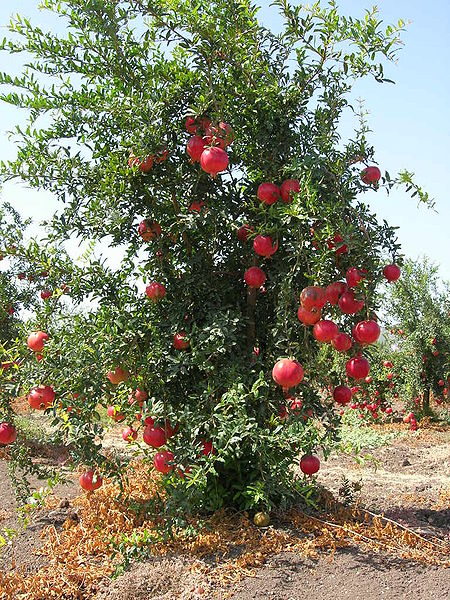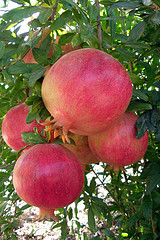Adaptations
In order to, not only survive, but thrive for thousands of years, Punica granatum has made multiple adaptations. Some of these derived characteristics are explained below.
A SWEET SMELL: Pomegranate flowers emit a sweet aroma. This
attractive scent
allures insects to the flowers, where they collect pollen. The
pollen is then carried to other pomegranate flowers, allowing
fertilization to take place.

THORNS: The branches of pomegranate trees are spiny. This is
advantageous for the survival of the species, as it aids in
protection. Many animals enjoy consuming the fruit and
leaves of this tree. The presence of thorns on the branches decreases
the probability of small animals reaching the ends of the branches.
Therefore, they are unable
to tamper with the fruit before it has reached maturity. The
thorns also protect
the leaves from being eaten. Consumption of the leaves results
in a decreased ability for the tree to photosynthesize and
prosper.
NUMEROUS SEEDS: Inside the outer covering of the fruit reside
many, many arils. Each aril contains one seed. Each seed has a
chance to be redistributed somewhere in the environment to grow
into a new tree. The fact that each fruit possesses a large
number of seeds puts the plant at increased odds of being able
to successfully complete its life cycle.

SOIL: The ability to thrive in a wide variety of soils gives Punica granatum an advantage in survival. Conditions do not necessarily need to be ideal for the species to persist.
HARD CASING: Pomegranate fruit is encased in a hard outer shell. This shell protects the seeds during development. It also increases the likelihood of dispersal. Since it is hard to digest, it is at increased odds of passing right through the digestive system of its consumer. Therefore, it will likely be released back into the environment to begin the growth of a new plant. The hard outer casing is visible in the picture on the right.
LIFE SPAN: Members of Punica granatum are long-living.
Some trees have been known to live longer than 200 years! This
greatly increases the chances for an individual to successfully
reproduce numerous times throughout its life. However, it is
important to note that fertility decreases with increasing age.
LEAVES: These are very important to the survival of this
organism. To find out how Punica granatum utilizes leaves, visit
NUTRITION.
